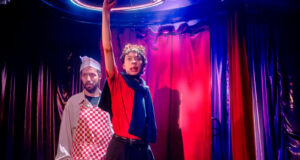Pros: Witty, eccentric and uniquely charming theatrics.
Cons: The venue was unwelcoming. A richly creative collaboration between costume, music and movement displays fierce talents at work.
Summary
Rating
Good
The only London date on this tour of Ladies and Gentleman was sold out, but despite Lea Anderson’s reputation there was an oddly flat atmosphere. This wasn’t so much down to the audience – who were the typical mix of funky looking students and stylish older dance connoisseurs – but to the venue.
On arrival, I found my companion sitting in an empty, echoing foyer, where a few people were whispering self-consciously. When my friend did succeed in finding the bar she reported poor service, and a charge for mineral water – the tap water being undrinkable due to lead pipes. Billed as being presented “in cabaret style”, in reality seating was simply arranged around tables dressed with white cloths. Nothing on the tables except a pile of dull feedback forms and biros. No music, no lowered lighting, nothing to create the intimate feel of cabaret.
Having formed her all female company The Cholmondeleys in 1984, and an all male company The Featherstonehaughs in ’88, Anderson has made over 100 works, been studied on the national curriculum, and received an MBE. Times change, and in 2011 Anderson was one of the unfortunate recipients of a 100% cut to her Arts Council Funding. She disbanded both companies. It’s worth noting that a sense of frustration and failure pervades Ladies and Gentlemen, which was made the following year.
Based loosely around the idea of a family of fading vaudeville performers, the characters take turns to perform surreal skits, accompanied by the other cast members on instruments such as ukulele, flute and kazoo, plus vocals. For all its apparent whimsy, the music is superbly arranged and impeccably performed. One sensed a kind of playful misdirection at work in the costumes too. Moustaches were worn on the forehead, bow ties on the face, and painted cardboard eyes on cheeks.
The choreography, although ostensibly based around lacklustre music hall tricks, was precise and technically accomplished. The cast of six formed a mesmerising mechanical clock, which gathered in complexity as circling globes of decreasing size were incorporated, and the self-made ticks and ticks of the timepiece accumulated. A take on a fan dance was musical and funny – the fans painted with crude illustrations of body parts and organs painted in blood red – alluding to mortality, and to the exposure of being a dancer.
There were other grimly macabre moments, as when the dancers responded to a song about having a brain tumour (performed by a man with a huge black growth strapped to his head) with a unified chorus of “ha ha ha”. The piece had an episodic structure – each skit ending with an anti-climax and the cast then moving purposefully around to re-set the stage, voicing a commentary on what they were doing at the same time. The need to perform, the frustration of performing, and the need to justify one’s actions emerged as themes. When a black cloth thrown over a wayward toy bird plunged the whole auditorium into darkness, the symbiosis between all theatrical elements was highlighted beautifully.
Skillful artists had clearly put a lot into this piece, but the steady episodic structure, combined with the sombre mood meant that it lacked the entertainment factor. Perhaps this is what Anderson intended, but it was a challenging fifty-five minutes, and it seemed a cruel irony that the atmosphere of failure was supported by the damp squib of a venue.
Choreography and Direction: Lea Anderson
Co-direction, Music and Words: Steve Blake
Design: Tim Spooner
Lighting: Simon Corder
Tour Production: Frazer Riches
Booking Until: This production has now finished its run.
 Everything Theatre Reviews, interviews and news for theatre lovers, London and beyond
Everything Theatre Reviews, interviews and news for theatre lovers, London and beyond



